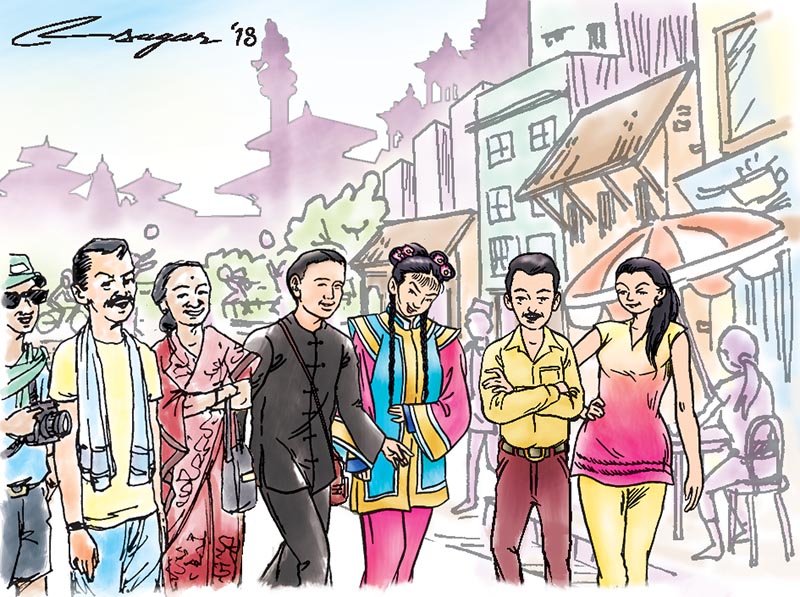Trilateralism via tourism: Promote people-to-people ties
Over these years, the tourism industry has been broadly recognised as an organised agent for international cooperation, as tourism offers a platform to enhance people-to-people relation
In his budget for the fiscal year 2018-19 presented in May, Finance Minister Yuba Raj Khatiwada laid emphasis tourism promotion for which he announced Visit Nepal 2020 campaign with an aim to attract two million foreign tourists in the coming two years.
This declaration will not only promote the tourism industry but also broaden Nepal’s prospects of international relations, particularly when it comes to balancing diplomatic ties with our two giant neighbours – India and China.
According to the Department of Immigration, Nepal has welcomed a total of 520,014 visitors on the first half of 2018, with 96,372 visitors from India followed by 71,379 tourists from China, covering one-third of the total number of tourist arrivals in Nepal. In the same period in 2017, 89,196 Indians and 52,084 Chinese visited Nepal.
At this point, it becomes imperative to discuss whether tourism can become the harbinger of trilateral cooperation between China, Nepal and India by making people-to-people relation the agent of change.
Over these years, the tourism industry has been broadly recognised as an organised agent for international cooperation, as tourism offers a platform to enhance people-to-people relation. The notion behind this recognition is that contacts among citizens from different lands pave the way for mutual relation, acceptance and understanding between foreign nationalities.
The interaction with diverse nationalities will provide a chance to revisit preconceived ideas and stereotypes, and in due course implant mutually positive perceptions of one another.
But tourism itself neither leads to automatic cooperation nor improves bilateral relations; it just works as a catalyst, and the rest depends on how the nation or its citizens respond to this opportunity.
In the present context, maintaining a good relationship with both India and China is a big challenge for the new government. In recent times, China seems inclined to expand its economic and strategic influence in Nepal. But India and Nepal have for ages enjoyed a unique relationship, with free movement of peoples from both the countries across the border.
Sandwiched between the two giant nations, Nepal while has the challenge to maintain relations with them, it also has immense opportunities to reap benefits from the two giant economies.
During his visit to China as the prime minister back in 2016, KP Oli had signed a host of agreements with Beijing. The 2017 elections brought Oli back to power, and Beijing seems keen to work with him in different areas of cooperation. All the while, Nepal also needs to maintain good relations with the southern neighbour. However, India-Nepal-China trilateral cooperation can be made possible through tourism if Kathmandu dares to experiment with innovative approaches. Governments are restrained by diplomatic protocols and political pressures, people are not.
If enough efforts are made from peoples’ side, we can certainly build a diplomatic triangle on different bases where people-to-people relation stands as superstructure, and governmental relations will gradually become stronger on the same foundation.
History books are inked with details that how human tendency of mutual connectivity is clogged by national borders and how governmental protocols stand as a barrier to contact between peoples from different lands.
According to intergroup contact theory, interactions amongst members of different groups help foster intergroup relations and reduce the feeling of “otherness”. Contact among diverse nationalities can help in establishing broader ground for multilateral ties between nations by improving social relations.
UNESCO also seems to be positive about this approach, as it has claimed that “contact between members of different groups is the key to ameliorating social relationship.”
All these theories and hypothesis, however, bring a question to the fore: what can bring together different nationalities in a shared culture so that they can accept each other’s uniqueness?
The answer is simple: Tourism.
Tourism these days has become a social force for promoting peace and understanding. As people travel across different civilisations to understand each other’s way of life and learn to assimilate amid diversity, it automatically connects individual dots to create a global human network. With tourism, people not only build relation, they embody it.
The proposition that tourism promotes tolerance and the international relation is not widely accepted by all stakeholders. Though there lack enough studies regarding the specific contexts under which tourism can endorse large-scale human relation, it is still believed to be one of the crucial factors. One should admit the reality that journey towards international cooperation cannot be an isolated tourism process; it is part of a greater social transformation that begins with the culture of accepting and tolerating diversity.
If pursued this strategy, someday Nepal can narrow the cultural gap between “Ni Hao and Namaste”. Then we will be a part of shared civilisation where geography would no longer be the destiny. Future will witness new model of human civilisation and it would be “connecting nations through tourism”.
Lamichhane is director, Nepal Tourism Board, and Poudyal is pursuing Master’s in International Relations & Diplomacy






